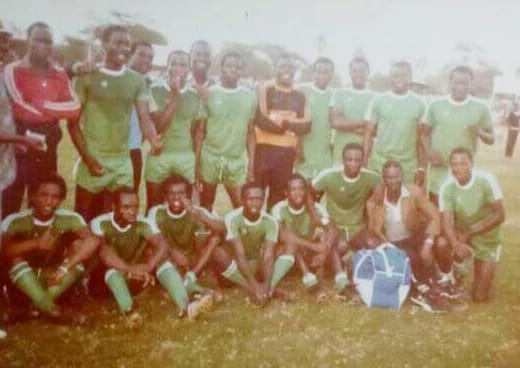1984 Kenya National Football League
Having won the 1983 KNFL, Gor Mahia under coach Len Julians were determined to prove that their league win was not a fluke. New arrivals to the team included players like Tirus Omondi, Abbas Magongo, George Onyango ‘Fundi” and Jaffar Mwidau. They were joined by regular stalwarts like Sammy Onyango “Jogoo” , Abdallah Shebe and Hezborn Omollo who formed a lethal attack that would score an incredible 86 goals in the campaign. The solid defence led by , Bobby Ogolla, George Otieno “Solo”, Peter Otieno “Bassanga”, Austin Oduor and new signing Tirus Omondi, was among the best , conceding only 27 goals. New signings Abbas Magongo and George Onyango, joined , John Okello “Zangi to form a brilliant midfield that created an avalanche of goal scoring chances.
Arch rivals AFC Leopards were also determined to wrest the title that they had given up the previous year. Among their new recruits included the likes of hard tackling full back Mickey Weche, the brilliant midfielders John Shoto “Lukoye” and Moses Mulamba, who joined his brother Wilberforce Mulamba in the starting lineup along with deadly strikers Wellington Lidonde, Joe Masiga and speedy wingers Mike Amwayi and Francos Kadenge. In defence, John Arieno, Josphat Murila and goalkeeper Mahmoud Abbas formed a reliable trio.
Military side, Scarlet FC of Lanet, who had finished second in 1983 also gave a good account of themselves. They boasted a star studded line-up with Ambrose Ayoyi ” Golden Boy” , the most famous player in the country alongside national team players like Charles Odero and goalkeeper Washington Muhanji who was finally emerging from the shadows of Mahmoud Abbas and establishing himself as the best goalkeeper in the country. Scarlet would concede the least number of goals, largely thanks to Muhanji. There was also players like the free scoring duo of Charles Odero and Jack Sihul who had been league top scorers in 1983 and 1982 respectively. Plus former Nyanam FC players Tom Odhiambo and George Ojwang.
Kenya Breweries were not too far behind. The arrival of Charles Otieno from Gor Mahia had vastly strengthened the side as he partnered with fellow international Douglas Mutua in the engine room. Former defender Joseph Chanzu who had become a striker proved a reliable goal scorer as did Neville Pudo. The duo formed a reliable attacking partnership with veterans Elly Adero and James Ouma “Jacaranda”.
Gor Mahia were in fine form throughout the campaign but AFC Leopards were equally sharp. In the end Gor Mahia won by only 3 points.

1984 CECAFA Club Cup
The 1984 CECAFA club was hosted by Kenya. It featured a full complement of teams from all the CECAFA nations. Zambia were represented by Nkana Red Devils. Zimbabwe were represented by Rio Tinto and Malawi were represented by Berec Power Pack.
Gor Mahia started slow with a 1-1 draw against KCC of Uganda. They then went on to beat Printing Agency and Al Hilal of Sudan 3-0 before beating Rio Tinto 2-0.
AFC Leopards were in a difficult group. They beat Small Simba of Zanzibar, Berec Power of Malawi and Young Africans of Tanzania 1-0 before drawing with Nkana Red Devils .
In the semis, Gor Mahia edged Berec Power 1-0 while AFC Leopards beat KCC 1-0. In an epic final, AFC Leopards beat Gor Mahia 2-1.
1984 CECAFA Senior Challenge Cup

1984 was a wake up call for Kenyan fans who had become accustomed to dominating the CECAFA cup. The tournament was held in Uganda. After winning the cup three times, Kenya’s Harambee Stars had a torrid time. They lost the opener 2-1 to Malawi, struggled to beat Zanzibar 1-0 before drawing with Somalia 1-1 and scraping through on penalties after Kenya and Somalia tied both on points, goals scored and goals conceded.
In the semis, Kenya lost 2-0 to Zambia with Philemon Mulala scoring a double. In the third place playoff , Kenya lost 3-1 to Uganda. By this time, Washington Muhanji had replaced Mahmoud Abbas as the first choice goalkeeper, further signalling the end of an era.
1984 Continental Events
Gor Mahia represented Kenya in the Africa Cup of champions. In the first round, they played Young Africans of Tanzania. The first leg in Dar es Salaam ended 1-1. John Okello “Zangi” had given Gor Mahia a first half lead. Young Africans scored a later equalizer. In the thrilling return leg, Gor Mahia pressed forward and created chance after chance but were frustrated by goalkeeper Joseph Fungo. Finally late in the game, Sammy Onyango picked up a pass from Abdallah Shebe and unleashed a thunderous long range drive to score the winner. Gor Mahia won the game 1-0 and 2-1 on aggregate.
In the second round, Gor Mahia were pitted against Egyptian giants Zamalek. The first leg was played in Cairo. Gor Mahia were playing extremely well to the surprise of the Egyptian crowd who expected to score an avalanche of goals. Len Julians displayed his tactical genius in particular, deploying the relatively unknown Juma Okoth as defensive midfielder. After 40 minutes, the referee whom Gor Mahia players perceived as biased, awarded Zamalek a dubious penalty. Abbas Magongo fouled a Zamalek player outside the penalty box. The player rolled into the penalty box and the referee inexplicably awarded Zamalek a penalty. Then the referee inexplicably showed Abbas Magongo a red card. It was then that all broke lose. Gor Mahia players confronted the referee over his bias. George Otieno “Solo” and Abbey Nassur assaulted the referee. Gor Mahia was then disqualified and 6 players and coach Len Julians were suspended for two years by CAF. Most of the players suspended were innocent and did not deserve a suspension.
Military side, Scarlet FC of Lanet, represented Kenya in the 1984 Africa Cup winners cup. Much was expected from Scarlet as they had almost won the league during the previous season and had a star studded team with several national team players.

